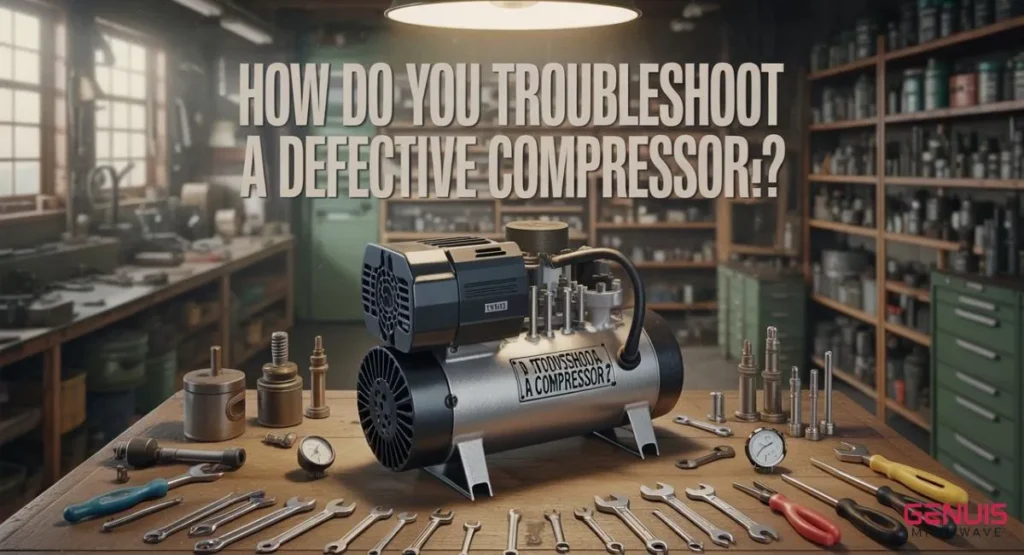How do you troubleshoot a defective compressor? From limited airflow and odd noises to total system shutdown, your compressor’s failure can cause major performance problems. Minimising downtime and avoiding expensive replacements depend on knowing the correct procedures for diagnosing and fixing typical problems.
This article will teach you how to spot signs like mechanical wear, pressure imbalances, overheating, and electrical issues. These troubleshooting tips will enable you to make wise judgements and maintain compressor running efficiency, whether your project involves an HVAC unit, refrigerator, or industrial air system.
What is a compressor?
A compressor is a mechanical device that reduces a gas’s volume, increasing its pressure. It compresses refrigerant gas or air, hence increasing its pressure and temperature.
What benefits does a compressor offer?
What benefits does a compressor offer?
Compressors are essential components of many systems, from HVAC to industrial pneumatic tools.
Here are some of the benefits of using a compressor:
- Compressors enable the efficient movement and use of compressed gas in a variety of applications.
- Maintaining the proper pressure level helps compressors guarantee optimal cooling and air supply systems.
- Their adaptability to many operating requirements helps them be used in many sectors, from manufacturing plants to refrigeration.
- In industrial environments, compressed air is sometimes safer than electrical power in certain situations.
How many types of compressors are there?
There are two main categories of compressors, each with several subtypes depending on design and application:
1. Positive Displacement Compressors
These compressors increase the pressure of a gas by mechanically reducing its volume in a confined space.
Subtypes:
- Reciprocating Compressors :
These condensers are used in small workshops and refrigeration systems. They use pistons and cylinders to compress air.
- Rotary Screw Compressors :
These compressors use two interlocking helical rotors to provide continuous compression. They are widely used in industrial applications.
- Rotary Vane Compressors:
Employ sliding vanes mounted on a rotor inside a cylindrical housing. Used in vacuum pumps and automotive applications.
2. Dynamic Compressors
These compressors use gas to provide momentum, which rotates the gas, which then converts the gas into pressure.
Subtypes:
- Centrifugal Compressors:
These compressors are commonly used in large HVAC systems and refineries. They use a rotating impeller to accelerate and expand gas, increasing the gas pressure.
- Axial Flow Compressors:
Rotating and stationary blades are used to compress gas along the axis of rotation. This is commonly found in jet engines and large-scale gas pipelines.
Why does a compressor break down?
While there are many reasons why compressors fail, the most common problems are mechanical wear, overheating, or electrical faults.
Low oil levels are a common factor that causes excessive friction and eventual failure.
Another common culprit is a starter relay or a bad capacitor, both of which are essential for starting operation.
Additionally, poor installation or lack of routine inspection can lead to premature failure.
In compressed air systems, for example, condensate trap problems can lead to moisture buildup and internal corrosion over time. If your compressor is running hotter than usual, consider finding solutions to cool the compressor and ensure that the cooling system is operating as it should.
Caution:
Compressor maintenance and regular industrial compressor servicing help identify these problems before they become more serious.
List safety precautions
Safety must come before you can figure out how to fix a faulty compressor.
- Always disconnect the power supply before looking at any component.
- Wear eye protection and gloves to prevent injury from sharp edges or unexpected pressure releases.
- Before starting any inspection, also manually relieve any accumulated pressure.
- Ensure the surrounding environment is dry and clean, particularly when using industrial machinery such as an Atlas Copco stationary compressor.
- Following the proper process guarantees you can safely finish chores, such as checking compressor hoses or changing pressure switches, without risking others or yourself nearby.
What Are the Common Symptoms of a Faulty Compressor?
Troubleshooting a failed compressor starts with identifying the indicators of such a failure.
The most common red flags are unusual sounds, poor airflow, regular cycling, and obvious leaks.
Insufficient refrigerant or internal damage may cause trouble if the compressor runs continuously without stopping.
A high dew point in compressed air indicates that moisture isn’t adequately eliminated from the system.
This can lower general efficiency and harm equipment downstream.
If your compressor produces loud knocking sounds or burning smells, it needs additional investigation or professional advice.
How to Troubleshoot Compressor Problems?
How to Troubleshoot Compressor Problems?
The procedure begins with a basic inspection of the circuit breaker and verification of the power source.
From there, test the capacitor, track the pressure, and check the oil level.
These first steps help determine whether the problem is minor or more serious.
If the compressor still does not operate as expected, it may be experiencing an unloader valve failure or a compressor valve leak.
Platforms like the SMARTLINK Monitoring System provide real-time diagnostics for industrial units, allowing you to remotely detect problems and understand compressor fault codes (Electronikon).
Finding the exact fault quickly will always help you proceed appropriately.
What Should You Check First When a Compressor Won’t Start?
Start with the basics:
Is the compressor plugged in?
Has the circuit breaker tripped?
Is the thermostat set correctly?
The issue often lies not with the compressor but with external components like wiring or controls.
If everything seems connected and powered, check the start capacitor—it’s a common point of failure.
Also, inspect the emergency shutoff switch, especially in commercial settings.
Sometimes, these switches trip during power surges or overheating events. If unsure, consult the user manual or contact Atlas Copco service support for guidance.
Early detection of these minor issues prevents bigger headaches later.
How Do You Inspect a Compressor?
Troubleshooting a malfunctioning compressor relies critically on visual observation.
Look for burnt wiring,
oil leaks,
broken hoses,
and terminal corrosion.
Look for hot spots using a thermal imaging camera.
Pay special attention to the status of the air filter replacement for compressors, as a blocked filter reduces airflow and causes the system to run roughly.
Additionally, pay special attention to when the compressor is running.
Strange humming or clicking could indicate a failing capacitor.
Loose mounting nuts or worn bearings can cause excessive vibration.
Many times, a simple inspection with careful examination reveals hidden problems.
Tools Needed for Diagnosis
To properly troubleshoot a broken compressor, you’ll need a few basic tools.
A pressure gauge measures the output level, and a multimeter checks voltage and continuity.
For a visual inspection, have insulated gloves, wrenches, and screwdrivers ready.
Industrial professionals sometimes rely on sophisticated equipment to find problems like compressor hose inspection failures or pressure drops, including thermal cameras and ultrasonic leak detectors.
If you handle high-end machines like Atlas Copco compressors, access to features like the SMARTLINK remote monitoring system can provide comprehensive diagnostics and fault logs.
Step-by-step troubleshooting method
Safety First: Power off before inspection and system depressurisation
Why is it thus vital?
Before beginning diagnostics or repairs, check that the system is de-powered and the compressed air system is depressurised. This serves to prevent unintended starts and electrical shocks, which might cause major injury to someone.
Action Plans:
Turn off the primary power source at the circuit breaker.
Opening pressure-relieving valves releases the remaining tank and line pressure.
Processes involving lockout/tagout (LOTO) should follow OSHA recommendations.
2. Power Cord, Circuit Breaker & Fuse Box: First Diagnosis
Why is it so vital?
Look over the power cord visually for burns, cuts, or loose connections.
Check the breaker on the circuit. Should it trip, reset it, then track whether it trips once more.
Action Items:
Older systems, notably, look at the fuse box for blown fuses.
Time Tip: Check during the first five minutes of diagnosis; it’s quick and usually points up the underlying issue.
3. Capacitor Testing Starting with a Multimeter: Electrical Fault Detection
Why is it crucial?
The start capacitor provides the initial torque to get the motor running. A weak or failed capacitor is a common cause of compressor failure.
Action Steps:
Safely discharge the capacitor with an insulated screwdriver or a resistor.
Turn your multimeter to capacitance.
Calculate the capacitance value. If the capacitor shows below 10% of its rated value, replace it immediately.
Example:
For instance, anything below 45 µF suggests a capacitor has to be replaced if it’s rated for 50 µF.
4. Routine Maintenance Check Every Six Months: Oil Level and Quality Inspection
Why it’s important:
Oil helps disperse heat and lubricates moving components. Low or deteriorated oil causes motor overload and overheating.
Action Steps:
Check the sight glass’s or dipstick’s oil level if one exists.
Should oil seem dark, milky, or include metallic particles, drain and replenish it.
Use the kind and viscosity advised by manufacturers.
Tip:
Always do an oil check for quarterly maintenance or every 500 running hours.
5. System control check: functionality and adjustment of pressure switches
Why is it so crucial?
System demand drives the pressure switch to regulate compressor turn-on and turn-off. Inappropriate settings can cause brief cycling or inability to start.
Action Steps:
Make that the cut-in and cut-out pressure settings follow manufacturer specifications.
Using the adjusting nut, change the differential as necessary.
Please verify that the switch makes the motor run as it should.
Note:
Replace the pressure switch right away if it is unresponsive or shows indications of corrosion.
6. Listening for Hissing Sounds: Air Leak Detection During Operation
Why is it thus crucial?
Even leaks in valves, fittings, or hoses can significantly lower efficiency and raise compressor load.
Action Steps:
As the system gets under pressure, spray the connections with soapy water.
Search for leaks shown by bubbles.
Replace or tighten problematic parts.
Tighten or replace faulty components.
Time Insight:
Leaks raise compressor wear and energy consumption. Hence, they should be fixed as soon as they are found.
7. Contact and control board inspection, the final diagnostic step
What makes it so important?
The electrical impulses that start and stop the compressor are controlled by the contactor and control board. The compressor will not operate due to burned contacts or failed boards.
Steps to Take:
Look about the area for evidence of burning, arcing, or discolouration.
OEM components will replace damaged contactors or control boards after continuity across the contactor terminals is tested using a multimeter.
Caution:
Before replacing any parts, make sure the control voltage matches the system.
Final Thought: Over Time Preventive Maintenance
When a compressor has a fault, engineers and technicians use an effective method to find the fault. In which the problem is found without any delay, and then the problem is solved. Regular inspection and periodic maintenance should be done. This process should be done after three to six months, so that this helps the compressor to continue to run for years.
What Is the Root Cause of a Compressor Failure?
Sometimes the outward signs cover a more serious problem. A blown capacitor or a seized piston could all be the underlying cause of a broken compressor. Common offenders also have electrical issues, such as burnt-out motors or shorted windings.
In industrial settings, motor overload faults in compressors are typically associated with inadequate ventilation or loading. Furthermore, moisture accumulation resulting from a malfunctioning condensate trap discharge problem causes corrosion and internal component damage.
Finding the actual cause guarantees dependability over time and helps prevent repeated breakdowns.
When to Repair vs. Replace?
Age, cost, and usage will all determine whether a compressor should be replaced or repaired.
If the compressor is still under warranty, repairs may be covered. If labor and parts costs are more than half the price of a new unit, replacement becomes a sensible option.
Regular failures or obsolete technology can also justify upgrading to a newer model, such as those covered by an Atlas Copco service plan.
Compressor inspection schedules help determine whether a complete replacement will improve energy efficiency and performance or whether ongoing maintenance is worth the cost.
CONCLUSION
Fixing a broken compressor helps you respond boldly when problems develop. With the correct knowledge, tools, and preventive plans, your system will function effectively and without problems. Early identification and wise decision-making are vital for a large-scale industrial compressor or a domestic AC unit.
Remember to utilise dependable tools, follow preventative compressor maintenance plans, and, when needed, call Atlas Copco service support. Being proactive will help your compressor last longer and prevent expensive downtime.
After reading the entire article, I hope you know how do you troubleshoot a defective compressor.



